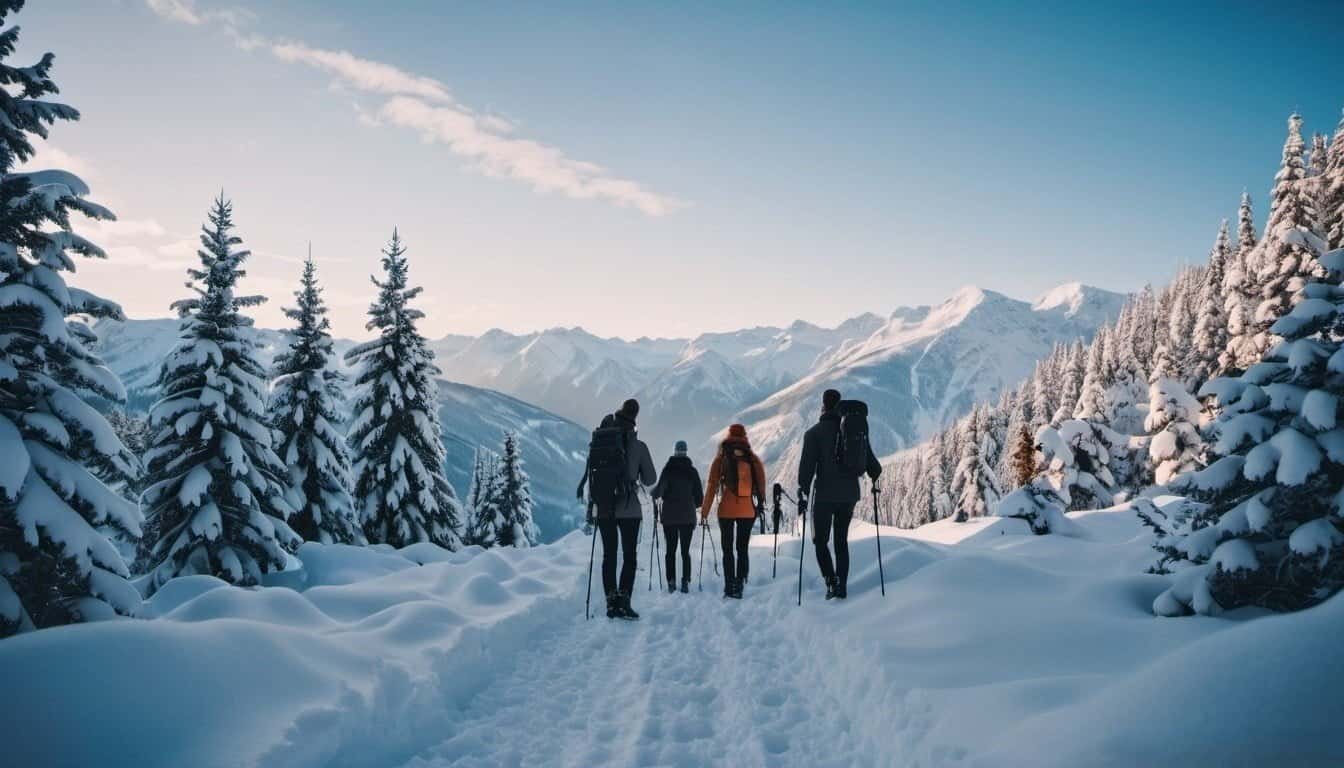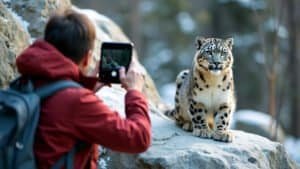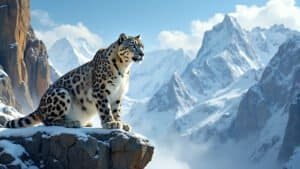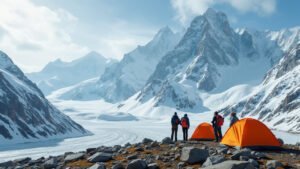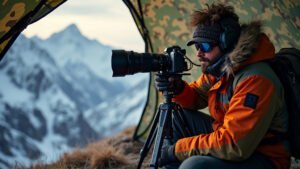Introduction
Responsible snow leopard tourism is crucial for ensuring the protection and preservation of these elusive and endangered creatures
As snow leopard habitats face increasing threats from climate change and human activities, responsible tourism plays a vital role in conserving their environment while offering unique experiences to travelers
In this article, we will explore what responsible snow leopard tourism entails, provide guidelines for tourists to minimize their impact, examine the role of tour operators, and discuss the ethical considerations necessary for snow leopard photography. By following these practices, both tourists and operators can contribute to the ongoing conservation efforts for snow leopards
What Is Responsible Snow Leopard Tourism?
Responsible snow leopard tourism is a specialized form of ecotourism that focuses on minimizing the impact of human activities on snow leopards and their fragile ecosystems
This approach emphasizes sustainable practices that not only allow tourists to experience these majestic animals in their natural habitat but also contribute to their conservation
The essence of responsible snow leopard tourism lies in balancing the needs of wildlife conservation with the interests of local communities and the desires of tourists
Definition and Importance
Responsible snow leopard tourism refers to the conscious effort to engage in tourism activities that prioritize the well-being of snow leopards and their habitats
This form of tourism is not just about viewing or photographing snow leopards; it is about ensuring that such activities do not disrupt their natural behaviors or degrade their environment. The importance of responsible tourism cannot be overstated, as snow leopards are classified as vulnerable by the International Union for Conservation of Nature (IUCN), with their population estimated at around 4,000 to 6,500 individuals globally
These big cats inhabit remote mountainous regions across 12 countries in Central and South Asia, where they are threatened by habitat loss, poaching, and retaliatory killings by local herders
Responsible tourism practices help mitigate these threats by fostering a deeper understanding and appreciation of snow leopards among tourists
Moreover, the revenue generated from such tourism can be channeled into conservation programs, providing financial support for anti-poaching patrols, habitat restoration, and community-based initiatives. By promoting responsible tourism, we can help secure a future for snow leopards in the wild
Key Principles of Responsible Tourism
Responsible snow leopard tourism is guided by several key principles aimed at ensuring minimal impact on the animals and their environment:
Sustainable Practices: Tour operators and tourists should engage in activities that do not harm the environment. This includes minimizing waste, reducing carbon footprints, and avoiding behaviors that could disrupt the natural habitat of snow leopards
Education and Awareness: Educating tourists about the ecological significance of snow leopards and the challenges they face is crucial. This knowledge fosters a sense of responsibility and encourages visitors to act in ways that support conservation efforts
Support for Local Communities: Ensuring that local communities benefit from tourism is a core principle. This can be achieved by hiring local guides, supporting local businesses, and involving communities in conservation activities. When local people see tangible benefits from snow leopard tourism, they are more likely to participate in and support conservation efforts
Minimizing Wildlife Disturbance: Maintaining a respectful distance from snow leopards and other wildlife is essential. Tourists should avoid loud noises, sudden movements, or any actions that might stress or disturb the animals. Observing snow leopards in their natural behavior from a safe distance not only protects the animals but also enhances the authenticity of the experience
Role in Conservation Efforts
Responsible snow leopard tourism plays a significant role in broader conservation efforts. By adhering to the principles mentioned above, tourists and operators contribute directly and indirectly to the protection of snow leopards
Financial contributions from tourism can fund critical conservation projects, such as camera trap monitoring, which helps track snow leopard populations and their movements. These projects are often led by organizations like the Snow Leopard Trust, which collaborates with local communities to implement effective conservation strategies
Furthermore, responsible tourism can help reduce human-wildlife conflict, a major threat to snow leopards. By providing alternative livelihoods through tourism, local herders are less likely to engage in retaliatory killings when snow leopards prey on their livestock. Instead, they become active participants in protecting these iconic cats
Guidelines for Tourists to Ensure Responsible Practices
When participating in snow leopard tourism, following specific guidelines is essential to protect these vulnerable animals and their habitats
Responsible practices help minimize the impact on the environment and ensure that snow leopards can continue to thrive in their natural surroundings. Tourists play a crucial role in this, and by adhering to these guidelines, they contribute to the overall success of conservation efforts
Maintaining a Safe Distance
One of the most important aspects of responsible snow leopard tourism is maintaining a safe distance from the animals
Snow leopards are notoriously elusive and solitary creatures, and close human presence can cause significant stress or even disrupt their natural behaviors. To prevent this, tourists should use binoculars or long-range cameras to observe snow leopards from a distance, ideally from several hundred meters away
Tourists should also avoid approaching cubs or denning sites, as this can lead to abandonment by the mother, severely impacting the survival of the young
In addition, staying on designated paths and avoiding off-trail exploration helps reduce the chances of disturbing these big cats and other wildlife. Tour guides should enforce these guidelines strictly, ensuring that all members of the group understand the importance of keeping their distance
Minimizing Environmental Impact
Tourists should also be mindful of their environmental footprint while engaging in snow leopard tourism. The remote and fragile ecosystems where snow leopards live are particularly vulnerable to human activities, so it is crucial to adopt practices that minimize environmental impact:
Waste Management: Tourists should carry out all waste, including food wrappers, plastic bottles, and other litter, to prevent pollution in the natural habitat. Biodegradable products should be used whenever possible, and waste should be disposed of in designated areas far from snow leopard habitats
Carbon Footprint Reduction: Traveling to snow leopard habitats often involves long journeys, which can contribute to carbon emissions. Tourists can offset their carbon footprint by supporting carbon offset programs or choosing eco-friendly travel options. Additionally, limiting the use of motorized vehicles within the habitat can reduce emissions and noise pollution, further protecting the environment
Respect for Flora and Fauna: Tourists should avoid picking plants, disturbing wildlife, or altering the natural landscape in any way. This includes not lighting fires in areas where it could damage the habitat or pose a risk to wildlife. By preserving the natural environment, tourists help maintain the delicate balance that allows snow leopards and other species to coexist
Ethical Photography Practices
Photography is a popular aspect of snow leopard tourism, but it must be conducted in a way that respects the animals and their environment
Ethical photography practices ensure that snow leopards are not disturbed or put at risk for the sake of capturing the perfect shot:
Avoiding Disturbance: Photographers should never use flash or artificial lighting, as this can startle and stress snow leopards, particularly in low-light conditions. Additionally, making loud noises or sudden movements to get the animal’s attention can disrupt their natural behavior and should be avoided
Using Proper Equipment: Long-range lenses are essential for photographing snow leopards from a safe distance. This allows photographers to capture high-quality images without needing to get too close, which could disturb the animals. Drones should not be used unless explicitly permitted by local regulations, as they can cause significant distress to wildlife
Respecting Wildlife and Habitat: Photographers should prioritize the well-being of the snow leopards over getting the perfect shot. This means avoiding risky behavior, such as getting too close to a cliff edge or intruding into a denning area. Additionally, all photographers should follow local guidelines and regulations, which are designed to protect both the animals and the habitat
Following these guidelines ensures that snow leopard tourism remains a sustainable and positive force for conservation. By respecting the animals and their environment, tourists help to preserve the natural beauty and ecological balance of the regions where snow leopards live
Responsible practices not only protect snow leopards but also enhance the overall experience for tourists, allowing them to witness these magnificent creatures in a way that is both ethical and sustainable
The Role of Tour Operators in Promoting Responsible Tourism
Tour operators are pivotal in ensuring that snow leopard tourism is conducted responsibly. They serve as the bridge between tourists and the fragile ecosystems where snow leopards live, guiding the practices and behaviors that can either protect or harm these endangered animals
By adhering to responsible tourism principles, tour operators can play a critical role in snow leopard conservation and the sustainable development of tourism in these regions
Educating Tourists on Best Practices
Education is the cornerstone of responsible snow leopard tourism, and tour operators are responsible for ensuring that every tourist is well-informed about the importance of conservation
Before any expedition, operators should provide comprehensive briefings that cover essential topics such as the ecological significance of snow leopards, the threats they face, and the specific guidelines tourists must follow to minimize their impact:
Pre-Trip Briefings: These sessions should explain why maintaining a safe distance from snow leopards is crucial, how to minimize environmental impact, and the importance of ethical photography. Tourists should be made aware that their behavior directly influences the well-being of the snow leopards and their habitat
On-Site Guidance: During the tour, guides should continuously reinforce these principles, reminding tourists of the need for quiet, respectful observation and adherence to established paths. By providing real-time feedback and education, tour guides can help prevent unintentional harm to wildlife
Post-Tour Follow-Up: After the tour, operators can continue to engage tourists through educational materials, newsletters, and follow-up communications that reinforce responsible tourism practices. This ongoing engagement can encourage tourists to become long-term advocates for snow leopard conservation
Implementing Sustainable Tourism Practices
Sustainable tourism practices are essential to the longevity of snow leopard habitats and the success of conservation efforts
Tour operators must adopt and promote strategies that minimize their environmental footprint while maximizing the positive impacts of tourism:
Eco-Friendly Accommodations: Tour operators should partner with eco-lodges and accommodations that adhere to sustainable practices, such as using renewable energy, managing waste responsibly, and sourcing food locally. This not only reduces the environmental impact but also supports local communities
Low-Impact Travel: Wherever possible, operators should opt for transportation methods that minimize environmental disturbance. This includes using non-motorized vehicles or organizing small group tours to reduce the overall impact on the habitat. Additionally, tour operators can offset the carbon emissions from their trips by investing in reforestation or other environmental projects
Sustainable Resource Use: Operators should ensure that the resources used during the tour, such as water and fuel, are managed sustainably. This includes reducing water usage, especially in arid regions, and avoiding single-use plastics by encouraging tourists to bring reusable water bottles and bags
Partnering with Conservation Organizations
Collaboration with conservation organizations is another vital aspect of promoting responsible snow leopard tourism. These partnerships can enhance the effectiveness of both conservation efforts and tourism practices by combining resources, knowledge, and influence:
Funding Conservation Projects: A portion of the revenue generated from snow leopard tours can be allocated to fund local and global conservation projects. Tour operators can partner with organizations like the Snow Leopard Trust or Panthera to support initiatives such as anti-poaching patrols, habitat restoration, and scientific research
Community-Based Conservation: Tour operators can work with conservation organizations to implement community-based conservation projects that involve local people in the protection of snow leopards. These projects can provide alternative livelihoods, such as eco-tourism jobs or sustainable agriculture, reducing the reliance on activities that might harm snow leopards, like livestock grazing in critical habitats
Collaborative Research and Monitoring: Tour operators can also collaborate with conservation organizations to support research and monitoring efforts. By contributing data from their tours, such as snow leopard sightings and habitat conditions, operators can help scientists track population trends and identify areas that need protection
Ethical Considerations in Snow Leopard Photography
Photography plays a significant role in snow leopard tourism, allowing tourists to capture the beauty and majesty of these elusive creatures
However, it is crucial that photography is conducted ethically to ensure that it does not harm the animals or their environment. Ethical photography respects the welfare of snow leopards and prioritizes their natural behaviors over the desire for perfect shots
Avoiding Disturbance for the Perfect Shot
The primary concern in wildlife photography, especially with elusive animals like snow leopards, is to avoid disturbing them
Snow leopards are highly sensitive to human presence, and any disruption can lead to stress, alter their behavior, or even drive them away from critical areas such as hunting grounds or den sites:
No Flash or Artificial Lighting: Photographers should refrain from using flash or artificial lighting, as these can startle snow leopards, particularly during low-light conditions or at night. The sudden burst of light can cause the animal to flee, potentially disrupting their natural behavior or endangering their safety
Silent Observation: To avoid startling the animals, photographers should remain as quiet as possible. This means not only avoiding loud conversations but also being mindful of the sounds made by camera equipment, such as the shutter. Using cameras with silent modes can be particularly helpful in reducing noise
Avoiding Provocation: It’s crucial that photographers do not engage in any behavior that could provoke a snow leopard to react, such as making noises, throwing objects, or attempting to get closer by leaving designated viewing areas. Provocation can lead to aggressive behavior or force the animal to abandon its current activity, whether hunting or resting
Using Proper Equipment
Ethical snow leopard photography requires using appropriate equipment that allows photographers to capture images from a distance, thereby minimizing the risk of disturbing the animals
The right gear not only ensures the safety of the snow leopards but also enhances the quality of the images:
Long-Range Lenses: Photographers should use long-range lenses (300mm or greater) to capture detailed images from a safe distance. This equipment allows for close-up shots without needing to approach the animal, thus maintaining the snow leopard’s comfort and security
Stable Mounts and Tripods: Using stable mounts and tripods is essential in low-light conditions or when taking long-distance shots. This reduces the need for artificial lighting and helps avoid blurry images caused by hand movements, allowing for clear, high-quality photographs
Drones and Remote Cameras: While drones can offer unique perspectives, they should be used with extreme caution and only where permitted by local regulations. Drones can be highly disturbing to wildlife, so operators must ensure they are far enough away not to cause distress
Remote cameras, placed by researchers or conservationists, can be a non-invasive way to capture images without human presence, though they should not be tampered with by tourists
Respecting Wildlife and Habitat
Respecting the integrity of the snow leopard’s habitat is just as important as respecting the animal itself. Photographers should always prioritize the well-being of the ecosystem and follow local guidelines to minimize their impact:
No Habitat Disruption: Photographers should avoid trampling vegetation, disturbing natural features, or leaving behind any waste. Even small actions, such as moving rocks or plants for a better shot, can have unintended consequences on the delicate ecosystem that supports snow leopards and other wildlife
Adhering to Local Regulations: It is crucial to follow all local guidelines and regulations designed to protect snow leopards and their habitat. This includes respecting no-go zones, sticking to designated paths, and obtaining the necessary permits for photography in protected areas
Promoting Conservation Through Photography: Ethical photographers can use their images to promote conservation efforts. By sharing photographs that depict snow leopards in their natural environment, along with information about the threats they face, photographers can raise awareness and inspire others to support conservation initiatives
Conclusion
Responsible snow leopard tourism is essential for preserving the delicate balance between human interests and the conservation of these endangered animals. By understanding and adhering to best practices, tourists can minimize their impact on snow leopards and their habitats
This includes maintaining a safe distance, reducing environmental footprints, and following ethical photography practices. Tour operators play a vital role in this process by educating tourists, implementing sustainable practices, and partnering with conservation organizations
Ultimately, responsible snow leopard tourism not only provides unforgettable experiences but also contributes significantly to the long-term survival of snow leopards and the protection of their natural environments. Through collective efforts, we can ensure that future generations will continue to admire these majestic creatures in the wild
